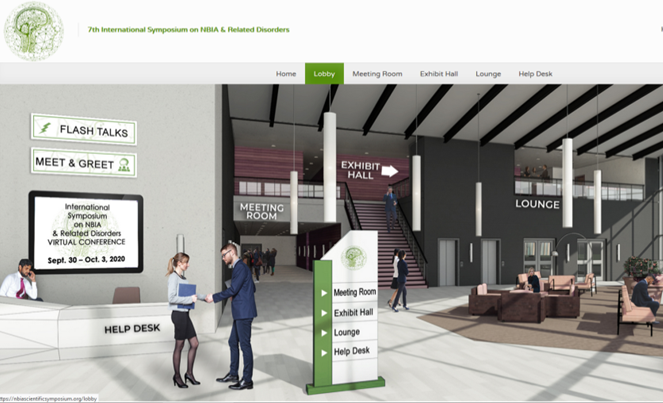Record number of participants at the 7th International Scientific NBIA Symposium
Autoren des englischen Originalartikels: Patricia Wood und Angelika Klucken
160 Teilnehmer aus 26 Ländern besuchten das 7. Internationale Symposium zu NBIA und verwandten Erkrankungen, das erstmals als virtuelle Veranstaltung stattfand. Da der online-Zugang es erleichterte, sich während der COVID-19-Pandemie im virtuellen Raum zu treffen, wurde diese Rekordanzahl an Teilnehmern ermöglicht, zu denen die weltweit renommiertesten NBIA-Wissenschaftler und -Kliniker gehörten sowie diejenigen Fachleute, die sich erst seit kurzem mit NBIA-Forschung und -Versorgung befassen.
Den Vorsitz im Wissenschaftlichen Lenkungsausschuss des Symposiums hatte Prof. Thomas Klopstock, Leiter des NBIA-Forschungsteams am Friedrich-Baur-Institut der Neurologischen Universitätsklinik München (LMU). Dem Vorbereitungskomitee gehörten ferner Prof. Susan Hayflick von der Oregon Health & Science University in Portland, USA, Prof. Valeria Tiranti vom Neurologischen Institut C. Besta in Mailand, Italien, und Dr. Agnès Rötig vom Institut Imagine in Paris, Frankreich, an. Die Patientenvertreterinnen Fatemeh Mollet von NBIA Suisse, Angelika Klucken von Hoffnungsbaum e. V. und Patricia Wood von der NBIA Disorders Association in den USA waren ebenfalls Ausschussmitglieder.

Das Bild zeigt die virtuelle Lobby des Symposiums. Teilnehmer konnten die Meetings oder Angebote anklicken, die sie wahrnehmen wollten.
Auf dem Programm der Tagung, die von der NBIA Disorders Association in den USA ausgerichtet wurde, standen Vorträge, in denen langjährige, erfahrene NBIA-Forscher und ihre Mitarbeiter*innen, über aktuelle Forschungsergebnisse berichteten. Darüber hinaus teilten Forscher, die neu in der NBIA-Gemeinschaft sind, jedoch über besonderes Fachwissen zu modernsten Therapieverfahren verfügen, ihre Kenntnisse und trugen zum Gedankenaustausch bei.
Das Sitzungsprogramm konzentrierte sich jeden Tag insbesondere auf ein oder zwei der häufigeren NBIA-Erkrankungen – PKAN, CoPAN, BPAN, MPAN, PLAN und FAHN, aber die Diskussionen über einzelne Erkrankungen waren für alle NBIA-Formen von übergreifendem Interesse. Insgesamt kristallisierten sich fünf krankheitsübergreifende Themen als Diskussionsschwerpunkte heraus:
- Entzifferung der pathologischen biochemischen Mechanismen der Krankheiten und damit Gewinnung neuer Ideen für mögliche neue Therapien
- Erkundung des Potenzials von Gen-, niedermolekularen Arzneimittel- und Zell-Therapien bei der Behandlung von NBIA-Erkrankungen
- Generierung geeigneter Tiermodelle und differenzierter Zellmodelle für vorklinische Tests
- Durchführung von Studien zu den natürlichen Krankheitsverläufen und Entwicklung geeigneter subtypspezifischer Bewertungsskalen als Voraussetzung für klinische Studien
- Durchführung klinischer Studien, die bevorstehen oder bereits laufen, und Anforderungen an deren Umsetzung.
Alle waren sich einig, dass eine ausreichende Finanzierung ein großes Hindernis bleibt, wenn es um die verschiedenen wissenschaftlichen Ansätze geht, die noch erforscht werden müssen. Ungeachtet des für eine Behandlung gewählten therapeutischen Ansatzes teilten die Forscher die Ansicht, dass parallel zu anderen Forschungsarbeiten die Studien zu den natürlichen Krankheitsverläufen (Engl: Natural History) nicht früh genug beginnen können, um aussagekräftige klinische Endpunkte zur Hand zu haben, mit denen man gut vorbereitet ist für klinische Studien, also so genannte Trial Readiness erzielt.
Patientenvertreter von 10 NBIA-Alliance-Mitgliedsorganisationen nahmen an der Konferenz teil, außerdem Vertreter der sieben Organisationen, die sich einer bestimmten NBIA-Erkrankung widmen. Biotech- und Pharmaunternehmen waren ebenfalls vertreten.
Die Teilnehmer hörten 37 wissenschaftliche Vorträge und sechs Blitzvorträge und konnten nach jeder Präsentation den Sprechern Fragen stellen. Darüber hinaus wurde jeder Tag mit dem Willkommensgruß eines Patientenvertreters eröffnet, der aus Patientenperspektive das Engagement der wissenschaftlichen NBIA-Gemeinschaft würdigte und ermutigte.
Jeder Tag endete mit einer lebhaften, für alle Teilnehmer offenen Diskussion über dringende Erfordernisse und nächste Schritte zu den in den Präsentationen behandelten NBIA-Krankheitsformen. An diesen Gesprächsrunden nahmen zwischen 50 und 75 Personen teil. Während des Symposiums wurden auch weitere Vernetzungsmöglichkeiten und virtuelle Ausstellungsstände angeboten.
Susan Hayflick, medizinische Genetikerin und Leiterin der NBIA-Forschung in Portland, Oregon (USA), schlug vor, dass sich die Forscher zusätzlich zu den persönlichen Symposien häufiger virtuell treffen sollten, um den wissenschaftlichen Austausch zu verbessern und die NBIA-Forschung zu beschleunigen. Viele stimmten dem zu und bewerteten die Qualität der auf dem Symposium verwendeten virtuellen Plattform als sehr gut.
Die meisten der Vorträge wurden aufgezeichnet und sind jetzt unter folgendem Link verfügbar:
https://NBIAscientificsymposium.org
Für Laien verständliche Zusammenfassungen der täglichen Vorträge sind in Arbeit und können demnächst von den gemeinnützigen NBIA-Patientenorganisationen zur Verfügung gestellt werden. Im Jahr 2021 wird das 8. Internationale Symposium zu NBIA und verwandten Erkrankungen vom 14. bis 16. Oktober 2021 als persönliches Treffen in Lausanne, Schweiz, stattfinden.
DieseÜbersetzung wurde durch www.DeepL.com/Translator (free version) is supported.
